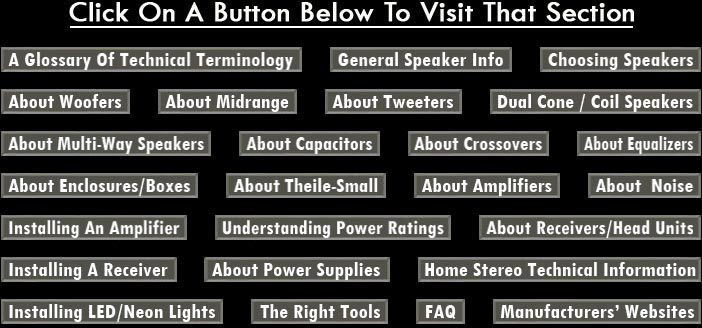


Fader
Rather like the right to left balance control, however the fader moves the sonic position between the front and back speakers.
Farad (F)
The basic unit of capacitance. A capacitor has a capacitance of 1F when a charge of 1 Volt across the capacitor produces a current of 1 Ampere through it. Named after Michael Faraday.
Fb
The tuned frequency of a Vented Enclosure, measured in Hertz. A combination of the resonance frequency of the air in a Port and the resilient pressure of the air in a Ported System. Below this point the Frequency Response of a Tuned Port system rapidly Falls Off, and the system can become unstable if asked to reproduce lower frequencies at high Amplitude.
FFT (Fast-Fourier Transform)
A method by which a system is described using an impulse response. Both frequency and time data can be extracted, with room reflections removed, providing an extremely accurate analysis. Mathematical manipulation of the data is employed to view system parameters from a variety of perspectives.
Feedback
See acoustic feedback.
Fidelity
A term used to describe the accuracy of recording, reproduction, or general quality of audio processing. Getting it "high" is every designer's goal
Filter
Any of various electric, electronic, acoustic, or optical devices used to reject signals, vibrations, or radiation of certain frequencies while passing others. Electronically, filters can be as simple as a single capacitor, or as complex as a dedicated computer circuit. For audio use the most common electronic filter is a bandpass filter, characterized by three parameters: center frequency, amplitude (or magnitude), and bandwidth. Bandpass filters form the heart of audio graphic equalizers and parametric equalizers.
Flat Response
An output signal in which fundamental frequencies and harmonics are in the same proportion as those of the input signal being amplified. A flat frequency response would exhibit relatively equal response to all fixed-point frequencies within a given spectrum.
Fletcher-Munson Curves
Fletcher and Munson were pioneering researchers who provided the basis of High Fidelity in the '30s. They accurately measured and published a set of plots showing the human's ear's sensitivity to loudness verses frequency. They conclusively demonstrated that human hearing acuity is essentially dependent upon loudness. The curves show the ear most sensitive to sounds in the 3 kHz to 4 kHz area. This means sounds above and below 3-4 kHz must be louder in order to be heard just as loud. For this reason, the Fletcher-Munson curves are referred to as "equal loudness contours." They represent a range of sensitivity from "barely heard," (0 dB SPL) all the way to "painfully loud" (120 dB SPL), usually plotted in 10 dB increments.
Flush (mounting)
Mounting a speaker in such a way that the speaker and its Grill do not protrude above the surrounding surface. Usually, this means mounting it at the back of the baffle board (the board the speaker is mounted on).
Flux
The flow of magnetic energy in a circuit. Flux density is the measure of the strength of the magnetic field typicaly used in speakers, and which governs its power handling capacity.
Former
The cylindrical portion of a speaker's voice coil section. A wire is wound around this cylinder to form a coil such that when current interacts with the magnetic field it produces a pumping motion that alternatively compresses and rarifies air, and creates the velocity for such air masses to reach our ears as sound.
Free-Air Configuration
This description usually indicates a speaker that, in the opinion of the manufacturer, is suitable for mounting in only a minimal enclosure, such as a baffle board that separates the back wave from the front.
Free-Air Resonance (see Fs) .
Free sound field
A sound field without acoustic boundaries or where the boundaries are so distant as to cause negligible reflections over the frequency range of audible sound. If the boundaries exist but completely absorb the sound then a virtual free field is created, thus anechoic chambers are used to accurately measure loudspeakers for their unique properties.
Frequency
1. The property or condition of occurring at frequent intervals. 2. Mathematics. Physics. The number of times a specified phenomenon occurs within a specified interval. In sound this simply refgers to the regular occurence of compression and rarification of air that we experience as sound.
Frequency Modulation (FM)
In radio broadcasting, a method of modulation in which the frequency of the carrier voltage is varied with the frequency of the modulation voltage (Also see Amplitude Modulation).
Frequency Response
The range of frequencies that a speaker will reproduce (lowest frequency to the highest). While the optimal normal is 20 - 20,000 Hz (Hertz), the range of human hearing for individuals is often much more restricted. A good full-range speaker system however, will reproduce as much of this range as possible in order to cover all variations. Individual Drivers are limited to reproducing only that part of the spectrum for which they were made, so their response will be limited, but still a necessary point to consider when designing a complete sound system.
Fs
Fs or Free Air Resonance is the frequency at which a speaker naturally resonates, like a tuning fork. Sometimes known as ringing response.
Full Logic Deck
A cassette mechanism where the tape operations are carried out by logic circuit operated solenoids rather than soley mechanical methods.
Fuse
A device designed to provide protection for a given circuit or device by physically opening the circuit. Fuses are rated by their amperage and are designed to blow or open when the current being drawn through it exceeds its design rating. They can be fast or slow acting, depending on type.
Fusible Link
Designed to perform the same task as a fuse, but the resembles a wire. Fusible links are commonly used in power transformers, ignition switches and other high current circuits.
F3 (measured in Hz)
The frequency at which the acoustic power output from a system has fallen to one-half its reference value. Known as the systems 3dB down point. F3: determined by the frequency at which the output is 3dB lower than the level at 100Hz. This frequency was chosen because it is a typical crossover point. In the case of a Bandpass system, F3 is determined by the frequency at which the output is 3dB lower than the level at the middle of the pass band.















